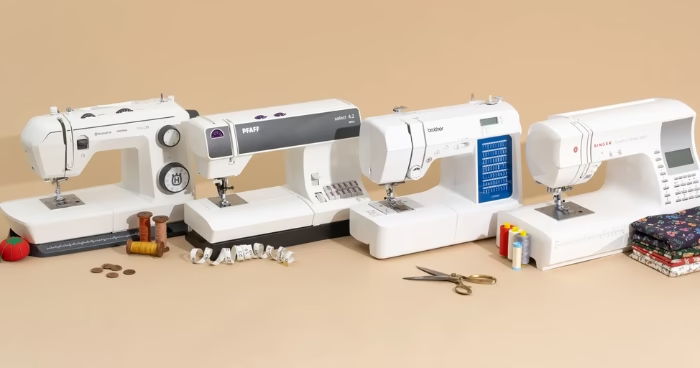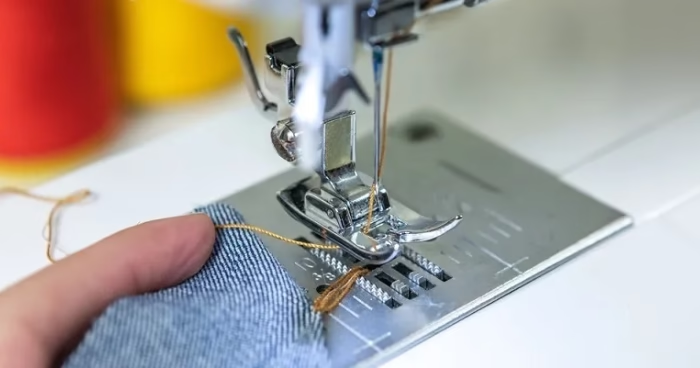How to use handheld sewing machine?
If you’re in search of a comprehensive tutorial on operating a handheld sewing machine, you’ve come to the right spot. Here, we provide you with detailed step-by-step guidance.
Rest assured, this resource is far more practical and user-friendly than sifting through a PDF of handheld sewing machine instructions or a manual for the Handy Stitch.
What is a Handheld Sewing Machine?
Handheld sewing machines offer a practical solution for those who require portable and precise stitching capabilities. Their compact, lightweight design makes them a popular choice among quilters, craft enthusiasts, and beginners. If you seek a petite sewing device capable of handling intricate embroidery tasks, handheld sewing machines are your go-to option.
Handheld sewing machines are tailor-made for such occasions when you’d rather avoid the bulk of a traditional sewing machine or the laborious use of a needle and thread. These handheld wonders are purpose-built to grant you enhanced precision and stability while working on your sewing projects.
Convenient, featherweight, and user-friendly, handheld sewing machines are effortlessly operated. Moreover, these machines are made of durable materials, they effortlessly handle a wide range of fabrics. They are the perfect companions for anyone seeking to mend small tears or secure loose threads.
While the sewing technology available in today’s market has evolved to encompass more complex models, the timeless and versatile handheld sewing machine continues to hold a special place in the hearts of traditional seamstresses.
How to use portable sewing machine Step-by-Step Instructions?
There are some steps related to the use of the handheld sewing machine that you should follow. This is how to use a portable sewing machine step by step. These steps are given here:
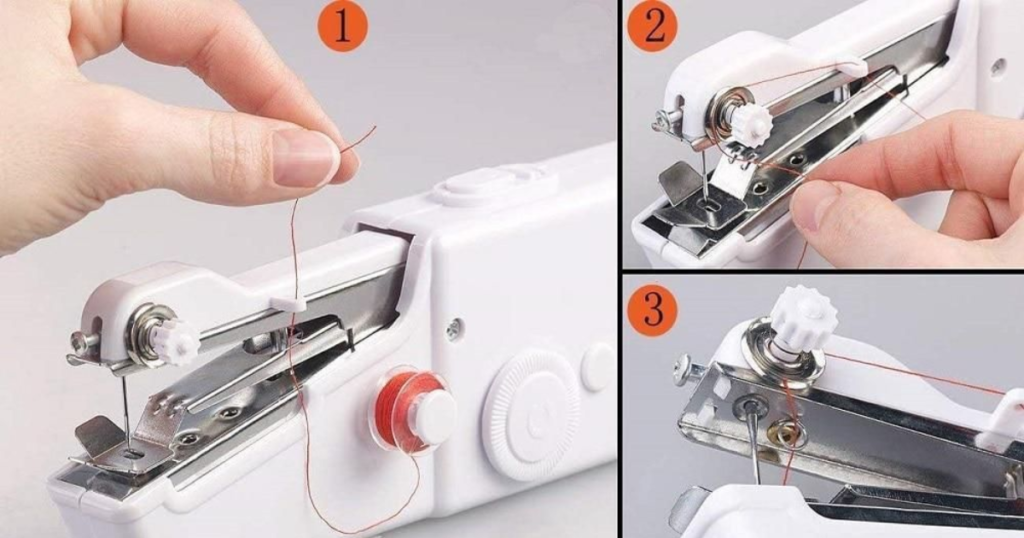
Step 1: Place the Battery cells inside the compartment
The first step to using a handheld sewing machine is to insert battery cells in the compartment of the sewing machine. This machine does not work without a battery. Because this machine works on the battery. If you do not insert the battery inside it does not start working.
Search for the place where you have to insert the battery. After searching put these four battery cells in their place. Ensure when you are going to insert the battery to put the cells in the sequence of the positive and negative.
Mostly the battery is located near the power button. So you can easily check it there. This step can proceed next to the coming step.
Step 2: Ensure the bobbin setting
The next step after the battery is to make sure of the setting of the bobbin in the machine. See the bobbin in the box and set it through the thread. Now check and remove the bobbin holder of the handheld sewing machine and be careful as there is a spring in it.
Make sure that this spring does not get loss. Fill the thread with the color you need. Insert the bobbin in the holder and place the holder back. The holder of the bobbin guides the bobbin to get the thread to the needles.
Step 3: Guide the thread to reach the needle
The next step after the bobbin setup is to guide the thread. Now you have to put the thread over the portable sewing machine. Guide the thread where it has to be hung and from where it enrols. Then it can reach the place where you have to put this to the needle.
Put this thread in the holes that are in the way and hang on the hangers that are made in the way. Put in the tension control and the thread finally reaches the needle. The holes and the circulating options in all the handheld and portable sewing machines are not the same. You have just to learn that you have to put the threads in the mini hand sewing machine.
Step 4: Ensure to make ready
Here when your thread reaches the needle. Then you should have to make sure the machine is ready for you to sew. You can make sure to sew the fabric when the thread is settled, the bobbin is fixed, the battery is fixed and the other all the extra matters are cleared.
This is how to set up a portable sewing machine. So, check all the parts of the machine, if these parts are ready to sew then you can proceed to the next step to sew the fabric. The next step is given here in detail.
Step 5: Sew the fabric
Here you have to sew the fabric when each and everything is ready. Take the piece of the fabric and start sewing it through the handheld sewing machine. Some people say that straight-line sewing through the handheld is difficult.
Then you can draw the line with a pencil. That line will not allow you to move anywhere. Hold the fabric and press the power button to sew. Ensure that the fabric, power button, and machine, all things are in your control.
If these are not in your control, you can not sew the fabric nicely. There may be faults in the fabric sewing. After completing the stitching, you have to lose the thread and take it out almost 6 to 8 inches gap from the needle and then cut the thread using the cutter or scissor.
If you follow these steps, you can come to know the use of sewing machines.
How To Use A Singer Sewing Machine For Beginners?
The use of the Singer sewing machine for beginners is the same. But there is a small difference between both of them in the battery and the power. Some machines use batteries and some work on power.
That difference you can understand when you buy a Singer sewing machine. They told you whether this machine works with battery or power. When you come to know, you can decide what to do next after this.
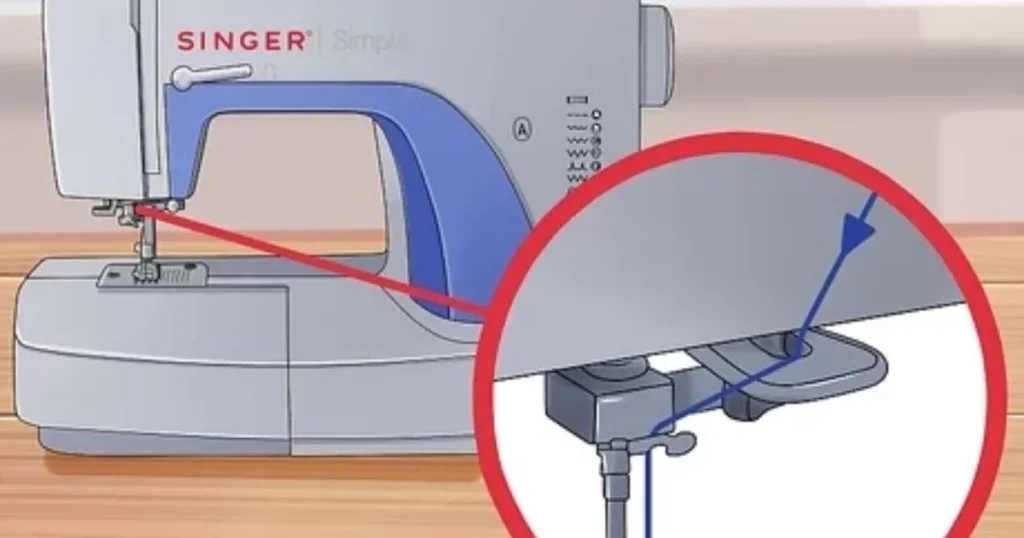
The above whole procedure is the same for the Singer sewing machine for beginners. These sewing machines are mini and portable sewing machines.
Are handheld sewing machines any good?
The value of a handheld sewing machine boils down to your budget and specific needs. If you prioritize high-quality stitching and have the space for a larger machine, that might be your best bet.
However, if you’re merely looking to tackle minor repairs around your home, then our mini sewing machines could be the perfect solution for you.
Advantages of Handheld Sewing Machines:
Simple Repairs: Mini sewing machines are great for handling basic repairs on your favorite clothing items, allowing you to salvage pieces with small seam issues.
On-the-Go Sewing: These mini wonders are ideal for sewing enthusiasts who are constantly on the move, providing a portable and convenient option.
Ease of Use: Modern mini sewing machines are designed with user-friendliness in mind, making them a solid choice for experienced sewers looking to streamline threading and needle changes.
Disadvantages of Handheld Sewing Machines:
Fabric Limitations: While these machines can handle various materials, not all fabrics are within their scope. Multiple layers or particularly thick fabrics can pose a challenge.
Stitch Quality: The stitches produced by mini sewing machines might not match the precision of those from a regular sewing machine, so intricate projects may be limited.
Thicker Fabrics: Some mini sewing machines lack the power to effectively sew through thick materials. If you require this capability, careful model comparison is essential.
Durability Concerns: Handheld sewing machines are known for their portability but may not be the most durable option. The plastic components are susceptible to damage, especially during travel, so handle them with care when packing them in your suitcase.
In sum, whether a handheld sewing machine is right for you depends on your sewing demands and expectations. Weigh the pros and cons against your specific requirements to make an informed decision.
In today’s world, sewing machines have become increasingly affordable, with many households boasting at least one of these versatile devices. Nevertheless, the quality of sewing machines can vary significantly, and it’s crucial to choose one that ensures maximum comfort during your sewing endeavors, making your projects as enjoyable as possible.
How to Choose a Handheld Sewing Machine?
For those who are new to sewing, opting for a lightweight machine may be the wisest choice. These models cater to individuals with basic sewing skills and offer simplicity in operation.
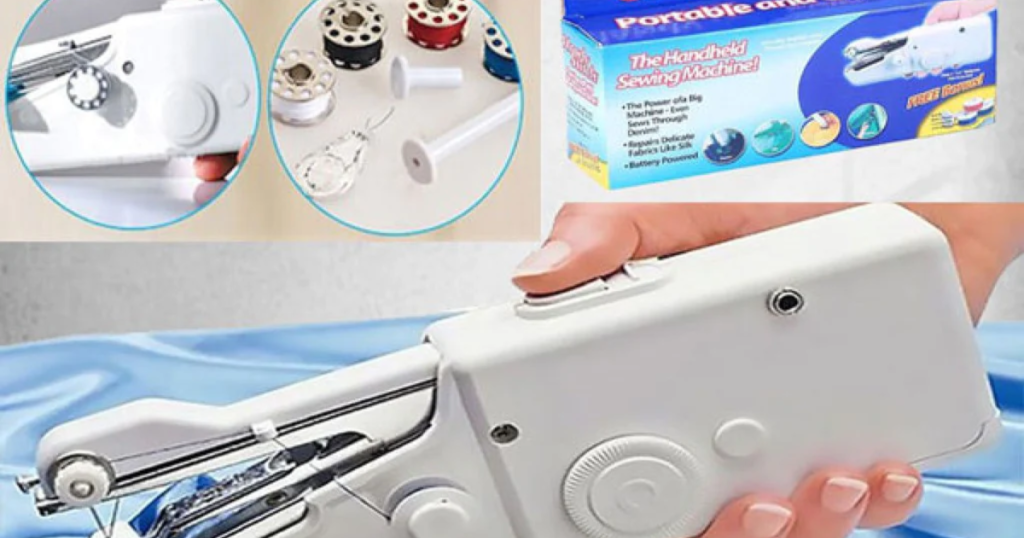
When it comes to basic sewing projects, a handheld sewing machine is your essential companion. However, it’s essential to note that these machines aren’t tailored for heavy fabrics and might lack the power to tackle coarse polyester threads.
The choice of sewing machine for your project hinges on the specific type and volume of stitching required. Heavy-duty projects are best left to traditional sewing machines, as handheld sewing machines are not recommended for such demanding tasks.
RELATED POST: Best Handheld Sewing Machines
FAQs:
What is the purpose of a portable sewing machine?
Portable sewing machines are almost always used in homes. You may tell them about the private machines. Use in the homes to make dresses and make the correctness in the holes in the dresses. You can use it also for tailoring purposes. But at a small scale.
Can we sew the denim in the mini portable machine?
Yes! you can sew the denim in the portable sewing machine. You can use it to sew three, or four layers of denim. Handheld and portable sewing machines are also used to sew the jeans. Some people say that the portable machines do not sew the jeans but they can sew the jeans easily.
What are the rules for using a portable sewing machine?
Here are some rules that you have to follow whenever you are going to sew in a portable sewing machine. the rules are given here:
- Pay your full attention to your hands and the work. If you are not paying full attention to them, there may be a mistake in the fabric sewing.
- Keep the sharp objects, hands, and scissors that are present here from the belt. As the belt does not harm.
- Keep your hands away from the needles and the areas which can harm your hands. Because taking care of yourself is also very important.
Can a handheld sewing machine sew thick fiber?
Yes! The mini and handheld sewing machine can sew thick fiber. But make sure the fiber is not thick enough, which the machine can not handle.
Conclusion:
A handheld sewing machine is a must-have tool for dedicated crafters. While it may not deliver the same level of quality as a standard sewing machine, it offers the incredible advantage of portability, enabling you to carry your sewing capabilities wherever your creative inspiration strikes, making crafting on the go a breeze.
